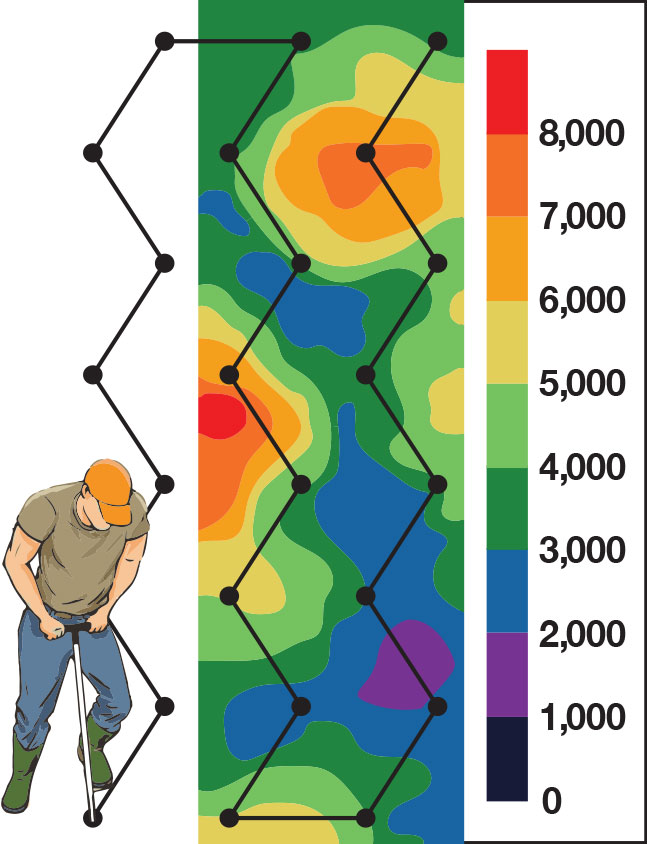[ Got Nematodes? find out now ]
SOIL TESTING for NEMATODES
SCN Diagnostics carries domestic and international permits to receive soil and plant samples from clients in all 50 states and many countries around the world.
Each year, a microscopic parasite known as the soybean cyst nematode (SCN), costs more than $1 billion in yield losses. SCN has spread to nearly all soybean producing states and continues to expand its reach abroad wherever soybeans are grown. Once in a field, the nematodes robust survival tactic means it is there to stay. The only option is to proactively manage the nematode population level through soil sampling, population typing, and the strategic deployment of resistant soybeans coupled with non-host crop rotation to reduce its impact on yield. SCN nonhost crops include alfalfa, barley, canola, clover (red, white, ladino), corn, cotton, forage grasses, oats, rye, sorghum, tobacco and wheat.
DO I HAVE SCN IN MY FIELD?
Absence of symptoms and planting of resistant soybean varieties does not mean you do not have an SCN problem. More than 80% of domestic farmland planted to soybeans is infested with SCN. The only way to know for sure if you have SCN in your field is to get an egg count test performed.
SAMPLING INSTRUCTIONS FOR SCN EGG COUNT
When sampling for SCN management purposes, take samples to represent the top 8 inches of soil directly at the root zone in the crop row. Soil should be collected over the entire field. Large fields should be subdivided into 10 acre sections. Collect 10 to 20 soil subsamples per section in a zig-zag pattern along the rows using a soil probe or shovel. Mix subsamples together, and send one pint-sized composite sample from each section to the laboratory.

SCN is typically not evenly distributed throughout a field. Therefore, the zig-zag sampling strategy shown below is used to collect representative soil samples. Red = high levels of SCN; Blue = low levels
When sampling for diagnostic purposes (i.e., is SCN present), collect soil from either:
- The margins of the area where plants are showing symptoms/declining, and/or
- Directly at the root zone.
- Where the SCN is most likely to be introduced into a field such as field entrances, areas that flood, fencerows or places where waterfowl congregate.
Soybean roots can be carefully dug up and examined for the presence of cysts throughout the growing season. The best time of year to take soil samples for SCN is in the fall right after harvest or before soybeans are planted the following spring. Nematode levels are highest following a soybean crop and at the end of the season. High population levels will increase the chance of detecting the nematodes in your field.
We also test soil and plant samples qualitatively and quantitatively for the presence of other plant-parasitic nematodes. Follow the sampling guidelines below to collect a soil sample. Check the box for a plant-parasitic nematode identification on the sample submission form.
Sampling instructions for specific plant types
- When sampling fields in row crops, take samples to represent the top 8 inches of soil. When possible, sample directly in the root zone. You can also sample the margins of areas where plants are showing symptoms or declining.
- Roots of declining plants can also be submitted to determine if any plant-parasitic nematodes are in them. For trees, call the laboratory for instructions.
Sampling instructions for specific plant-parasitic nematodes
- Population levels are highest at the end of the growing season.
- Nematode population levels decrease when host plants are absent, which makes detection difficult and unreliable as a predictor of problems in the next growing season.
Root-knot nematodes
- Look for galls or “knots” on the roots at the end of the season, which is an indicator of root-knot nematode presence.
- Sample soil in the root-zone of plants at the end of the growing season before plants senesce.
Golf green nematodes
- Nematode levels are highest when the plants are under stress, typically July-August.
- Using a cup cutter or soil probe, take a soil sample to a depth of 4-5 inches.
- Note: The lab checks only for presence or absence of certain plant-parasitic nematodes.
Pinewood nematodes
- Sample branches greater than one inch in diameter or the tree trunk of symptomatic trees.
Foliar nematodes
- Submit symptomatic foliage.
Please call 573-884-9118 or send an email to scndiagnostics@missouri.edu for information on sampling procedures and specific instructions. Sampling procedures will change depending on host and plant-parasitic nematode.
CARE OF SOIL AND PLANT TISSUE SAMPLES
Proper collection and care of samples is extremely important. Take samples when soil is moist. Put samples in plastic bags, with the label on the outside. Do not let samples dry out! Nematodes are sensitive to heat. Keep samples in a cool, dark place until they can be mailed. Do not leave samples in the sun or other areas of high temperature.
PACKAGING AND MAILING
- Fill out the sample submission form as completely as possible.
- Label the sample bags with the submitter's name and sample ID designation given on the sample submission form.
- Place sample and submission form in a cardboard mailing box.
- Mail samples to SCN Diagnostics:
SCN Diagnostics
1721 East Campus Loop
University of Missouri
Columbia, MO 65211-5547
For any questions, please call 573-884-9118 or send an email to scndiagnostics@missouri.edu.
 For Better Beans
For Better Beans